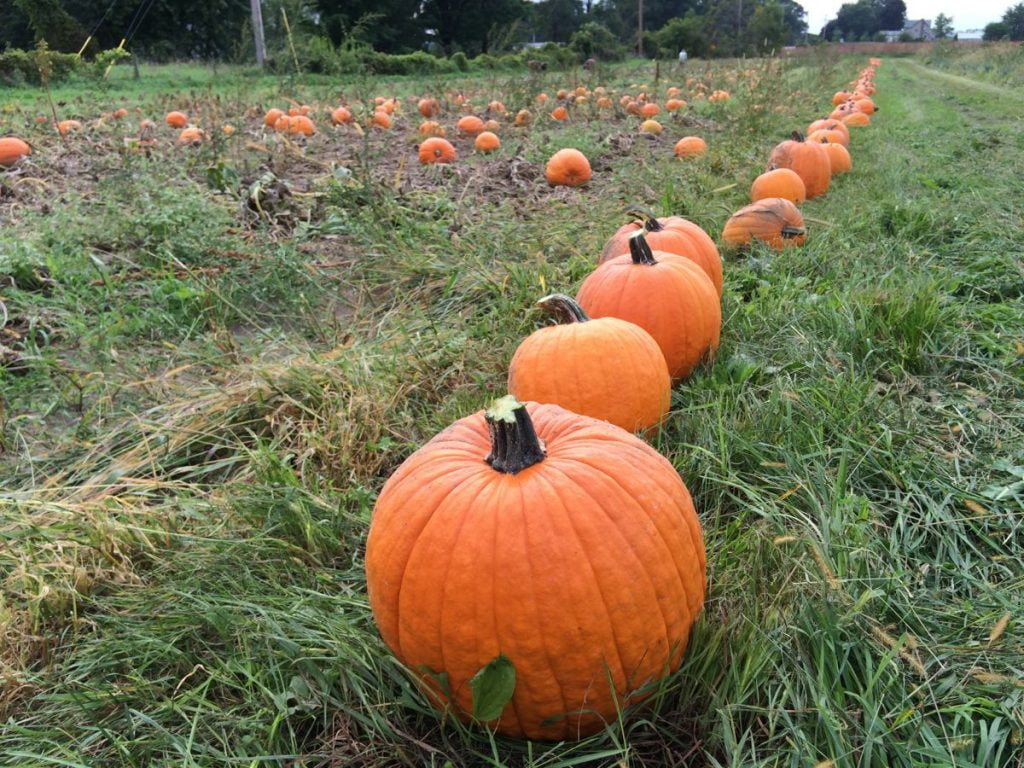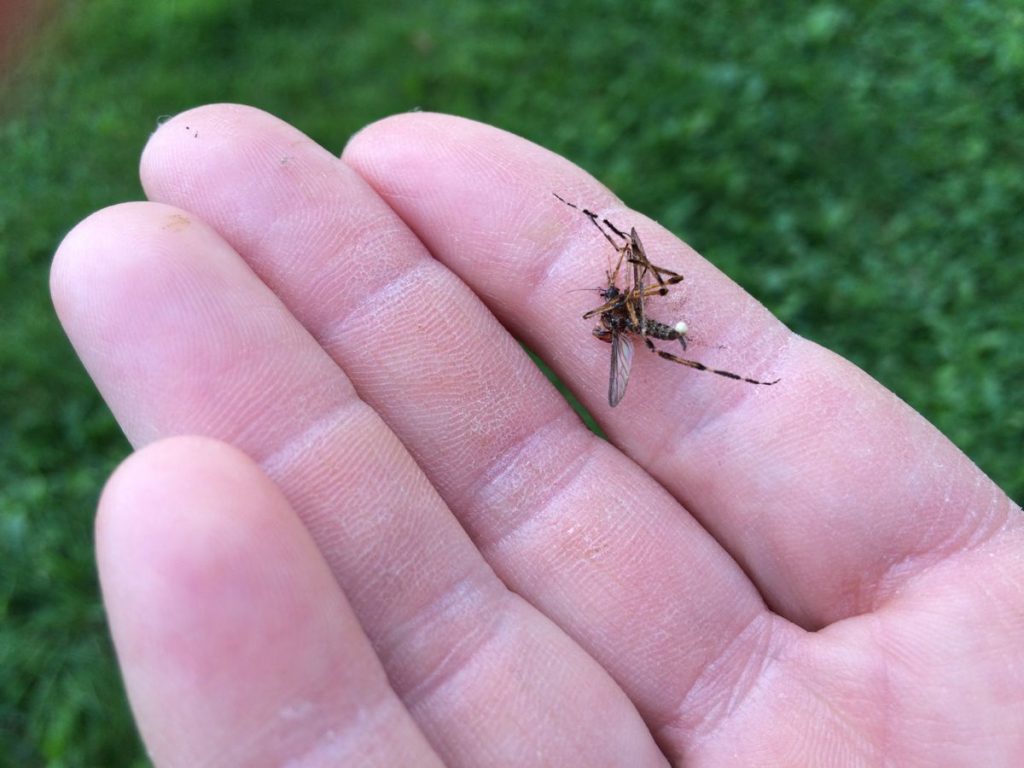Monthly Archives: September 2016
Box Logic
- On: September 28, 2016
 0
0
As we plan each CSA box, we look for logical combinations. I’d like to share our thought process in designing this week’s box. I think it will help you cook and enjoy the produce.
Potatoes and leeks are an obvious choice to send together so you can make potato-leek soup, or warm the house with a potato-leek casserole. Check out Lauren’s recipe below for Potato and Leek Fritters. It’s a twist on the classic combo and sounds like perfect comfort food to me.
The Zavory chiles have excellent flavor with minimal heat, and will work well with the potatoes. Parsley combines well with almost everything in the box; beans, potatoes, peppers. You may have noticed (and wondered) why we have sent so many frying peppers this year. They have consistently been the best quality peppers on the farm this season, and very delicious, so we’ve sent them multiple times.
In summer, we fill the boxes with what the farm offers. There’s a steady supply of tomatoes, peppers, melons, zucchini, sweet corn, etc. We pack a member of the onion family in every box because they are essential in cooking. Then we choose a mix of items that can be eaten raw versus cooked, to make the box easy to use. If a vegetable is unstoppable in the field (tomatoes!) then it is in every box. If it’s not (fennel) we pack it with the vegetables we think it combines best with (tomatoes, garlic).
In fall, we can be more strategic. For example, we plan to alternate starchy vegetables in the upcoming boxes, from potatoes to sweet potatoes to winter squash. Then we add at least one brassica (broccoli, Romanesco, cauliflower, cabbage) as well as some type of greens (kale, bok choy, napa cabbage) plus alliums (onions, leeks, garlic). Then we fill in with all the other special things of the season, items like scallions, celeriac, parsnips and winter radishes. In summer, the boxes are driven more by volume, by the limits of what we can fit in the box. In fall, there are as many items (and as much weight) but less fluff, so the boxes are not as full and are simpler to pack.
Here’s what I plan to cook this week. The weather has cooled so we will turn on our oven and roast a pan of potatoes, onions and garlic, using our favorite (and adaptable) recipe for roasted veggies. We’ve already prepared many of our favorite pepper recipes this summer, so I plan to make a sauce with roasted peppers and onions, parsley, Zavory chiles and garlic. In a household of ‘diverse’ eaters, it helps to have a sauce on the side to enliven oven-roasted potatoes or steamed beans. Even if you dress your steamed beans in a light vinaigrette, adding roasted pepper sauce at the table is a nice boost. I’m intrigued with this roasted carrot harissa recipe, and will adapt it to extend my roasted pepper sauce.
Finally, remember you can freeze any extra peppers, whether raw or roasted. You will enjoy them this winter. Beth
Farm News
You will notice that no one is wearing mosquito nets in the photos below. The mosquitos have abated, freeing us from our net suits. We continue to work around the rainy weather. We accomplished a lot in the fields on Monday and Tuesday so we could focus on indoor jobs when it rained on Wednesday.
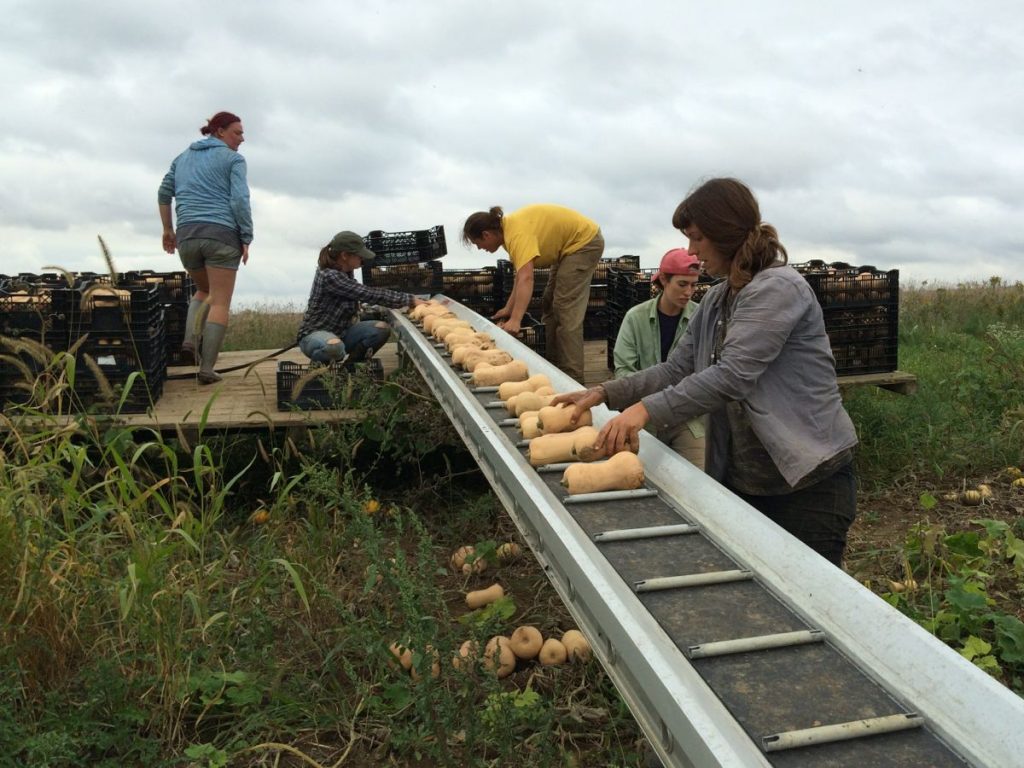
Butternut harvest is complete. From right, Charlotte and Lizzy load squash onto the harvest conveyor belt we take to the field. On the wagon, Jory, Karen and Madeleine pack and organize the squash. The butternuts are curing in our warm, dry greenhouse.
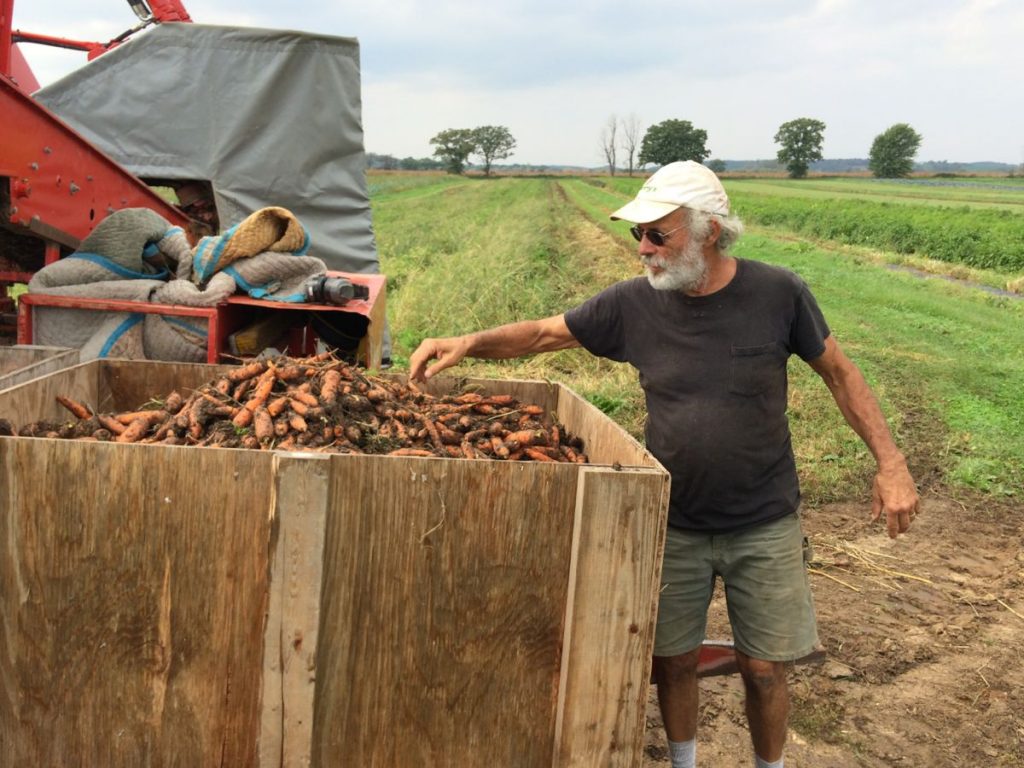
Steve, Ari and I harvested carrots during a dry spell over the weekend. Carrot harvests will continue into November.
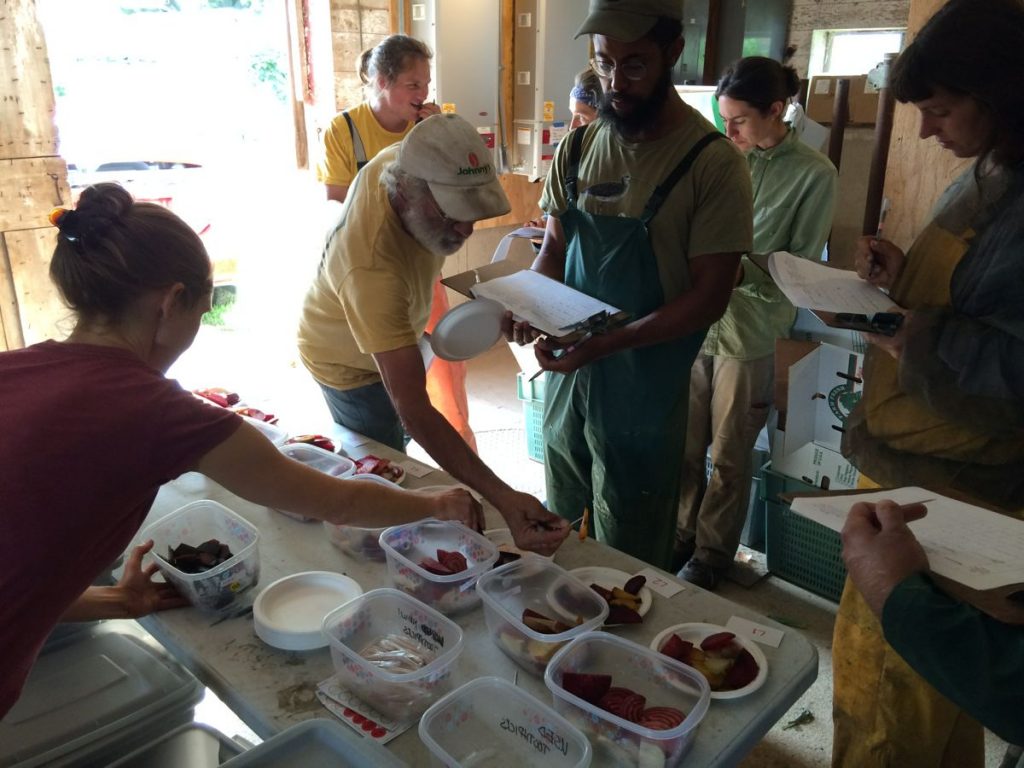
We hosted beet trials this summer for UW graduate student Solveig Hanson (at left in photo). Solveig is breeding beets for specific flavor and color profiles. She returned to the farm this week for us to sample and evaluate her breeding lines. The range of flavors is quite interesting. As a group, we are a mix of beet-lovers, beet-haters and beet-ambivalent types. Almost everyone found a breeding line they found appealing. You will have a chance to sample Solveig’s beet lines at our gleaning party. Stop by her table.
Veggie list and veggie notes (Sept. 29/30, 2016, week #20, purple EOW)
Satina yellow potatoes, 3.5 lb
Leeks, 1 lb
Broccoli, 1.25 – 1.5 lb
Romano beans, ~1.6 lb
Carrots, 2 lb
Yellow onions
A mix of peppers, mostly frying peppers, about 5 – 6
‘Zavory’ not-hot habanero chiles, a handful
Parsley, 1 bunch
Garlic (maybe?), 1 bulb
Next week’s box will probably contain sweet potatoes, bok choy, scallions, peppers, broccoli, edamame soybeans, and more.
Satina potatoes – These pale yellow potatoes are from our friends out at Driftless Organics. Satinas are an all-purpose potato with thin skin and smooth flesh. We oven-roasted a batch and they browned perfectly.
‘Zavory’ habaneros (small, orange or red) – These habaneros are NOT HOT. Almost all the spice has been bred out of them, leaving mild heat in the seeds. Now we can all learn what habaneros actually taste like. The blazing heat always got in the way, as normal habaneros are about 200,000 Scoville units. Lo-and-behold, these Zavory chiles have great, fruity flavor, really interesting. You should still approach them with caution. We’ve found rare off-types mixed in, but very infrequently, and not with the full heat of a normal habanero. As always, remove the seeds if you want to reduce the risk of spiciness.
RECIPES FROM LAUREN
MASHED POTATO & LEEK FRITTERS
Takes 1 hour
Makes 14-15 pancakes
2 pounds yellow potatoes, cubed
1-1/2 teaspoons Kosher salt, divided
2 tablespoons butter
1/2 cup whole milk
1 large leek, white and green parts only, halved lengthwise and sliced
2-3 Zavory peppers, seeded and minced
2 tablespoons minced parsley
2 eggs
1/3 cup fresh breadcrumbs or panko
1/4 teaspoon freshly ground black pepper
1 tablespoon olive oil
2 tablespoons vegetable oil
- Place potatoes and 1 teaspoon Kosher salt in a large pot. Cover with water and bring to a boil over high heat. Once boiling for 15 minutes, drain water and mash potatoes. Stir in butter and milk until thick and creamy. Add additional milk if needed to thin. Measure out 1-1/2 cups for the fritters. Save the rest for another use.
- Combine mashed potatoes, leeks, peppers, parsley, eggs, breadcrumbs, remaining salt and ground pepper in a large bowl. Stir until smooth. The mixture will be loose and wet, but this is just fine!
- Heat oils in a large skillet over medium-high heat until very hot but not smoking. Drop spoonfuls of the potato mixture into the hot pan in two tablespoons piles being careful not to crowd the fritters. Flip once browned (2-3 minutes) and then press down with a spatula to flatten. Remove from the pan once both sides are browned and gently move to a paper towel. They will still be quite delicate. Keep the first batch in the oven at 200 degrees if you like while you prepare the rest.
- Serve warm with sour cream and some additional chopped parsley.
———-
COLORFUL BROCCOLI SALAD
Takes 15 minutes
Makes 6 cups
1 large head broccoli
1/2 cup buttermilk
1/3 cup mayonnaise
2 tablespoons cider vinegar
1 tablespoon sugar
2 red frying peppers, diced
1/2 yellow onion, diced
1/3 cup dried cranberries
Kosher salt and freshly ground black pepper
- Bring a large pot of water to a boil over high heat.
- To prepare the broccoli, cut off the florets and roughly chop into bite-size pieces. Take the broccoli stems and cut into small matchsticks.
- Once the water is boiling, add just the broccoli florets (not the stems) and blanche for 3 minutes then strain and rinse under cold water.
- Combine buttermilk, mayonnaise, cider vinegar, and sugar in a large bowl. Whisk until smooth. Add broccoli, broccoli stems, peppers, yellow onions and cranberries to bowl and stir with a spatula until dressing coats salad.
- Season with salt and pepper.
———-
LOCAL THYME RECIPES
Comforting Classics
Broccoli Almondine
Buttered Romano Beans with Leeks
Italian Rice Stuffed Peppers
Pot Roast or Portabello Pot Roast
Outside the Box Recipes
Roasted Broccoli Persillade
Romano Bean, Potato and Meatball Stew
Sweet Italian Pepper Sauce with Capellini
Carolina Cabbage and Carrot Slaw
Quick and Easy Meal
Sweet potatoes are up, squash is down
- On: September 21, 2016
 0
0
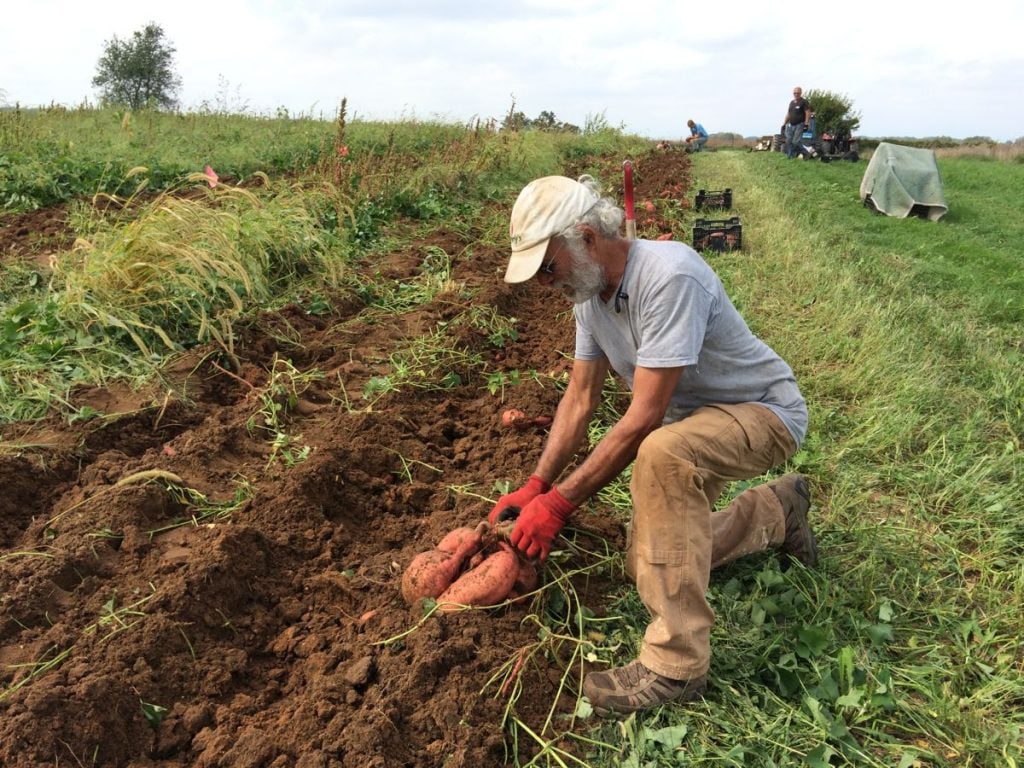
Steve pulls up a beautiful hill of sweet potatoes. Steve undercuts the rows to lift the roots to the surface, then we pick them up by hand. It’s not a fancy method but gets the job done.
We dug our first sweet potato harvest last Friday. This is a preliminary harvest, enough for one CSA delivery. The roots are curing in a hot, steamy room, and will be ready in a week or two. Based on this early sampling, looks to be a good sweet potato year. This surprised us, considering how rainy it’s been. Sweet potatoes grow well in dry, thin soils and (supposedly) dislike wet soil. We did not find any rot as we dug on Friday, which was a relief. If the rest of the fields are as good, we might have enough sweet potatoes for an extra delivery.
Sweet potatoes and winter squash seem to cycle opposite each other. If one crop does poorly, then the other does well. Overall, this is a middling winter squash year. The butternuts look as sturdy and prolific as usual but other types like delicata and acorn squash did not do well. They got really close to harvest, then rotted before ripening. Chalk it up to the wet year. Winter squash is one of “my” crops so I gnashed my teeth a lot as the plants went downhill. However, it was an excellent year to test new varieties! If a variety thrived and produced tasty squash, then it’s probably a keeper. We will send the most promising types to a few sites this week. We’d love to hear what you think of them. Follow the link in the newsletter to give us your feedback.
I have mentioned the wet weather frequently this summer but we remain grateful that the spring weather was dry. Our biggest problem now is that weeds are overtaking our farm. Steve and Jeremy cultivated repeatedly but the weeds re-root each time it rains. I’ve talked with a few farmer friends over the past weeks and all expressed impatience to get this season finished. We’ve heard difficult stories from friends in western Wisconsin and Minnesota where it has rained all season. Here’s a piece written by a farmer friend struggling to grow vegetables in Minnesota, and wondering if our climate is suited to vegetable production at all.
Beth
Willy Street Parade
The highlight of our week was our annual trip to the Willy Street parade. As usual, we were fueled by our crew’s enthusiasm and creativity. Maggie printed a new Tipi t-shirt, based on Karen’s artwork. It is so lovely. We handed out Oranos peppers and Romano beans. The peppers got a much more enthusiastic response!
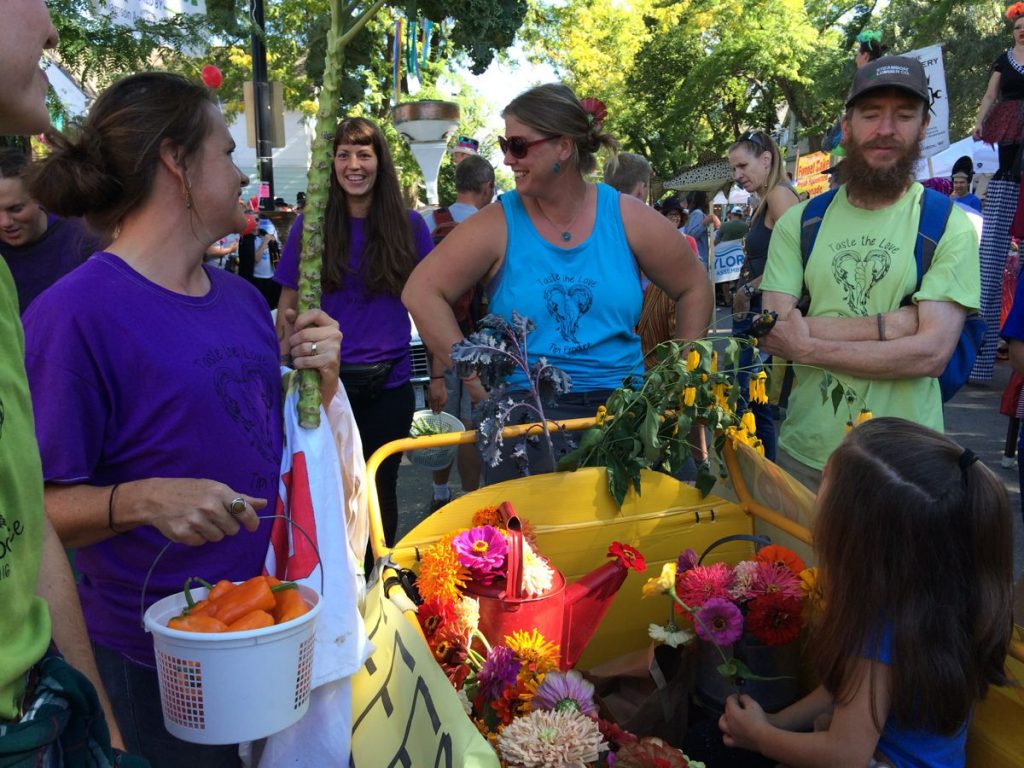
Karen, Charlotte, Maggie, Ken (Tipi alumnus) and Charlotte’s daughter prepare for the parade. Maggie loaded her new pedi-cab with flowers to toss to the crowd.

James hands out beans, wearing a mosquito net. They are our uniform these days.

James, Charlotte, Jory, Kelsie, Jim and Madeleine.

Our tallest fan enjoys a pepper.
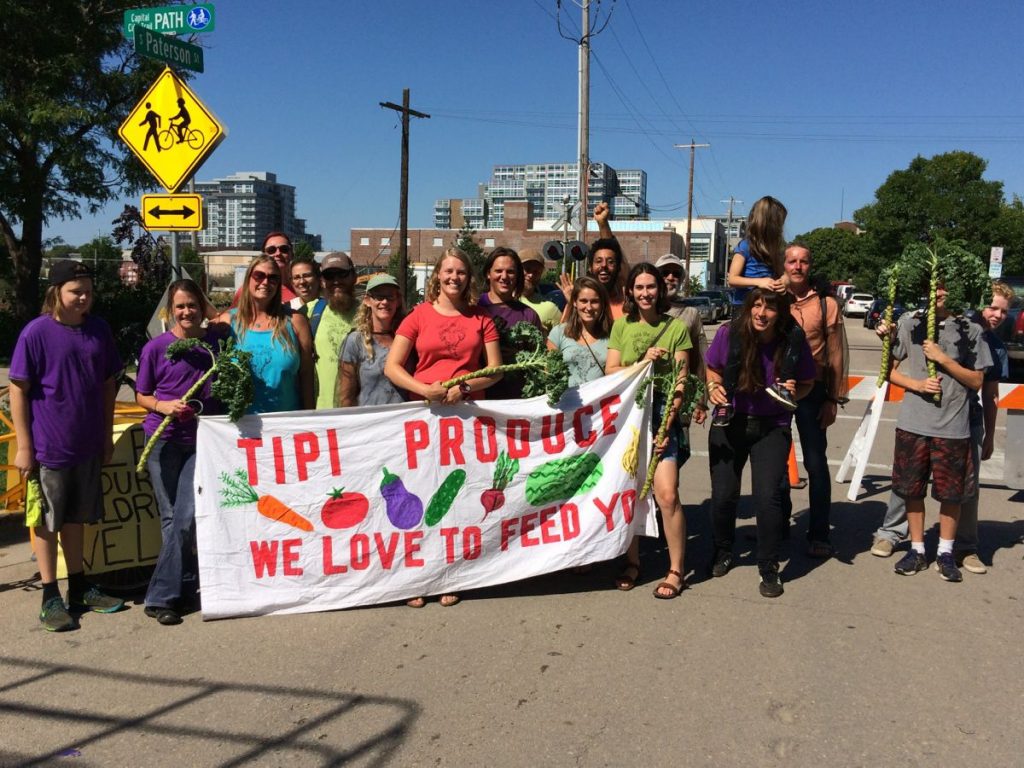
The parade crew assembled. It’s not the entire Tipi crew but was a good turnout.
Veggie list and veggie notes (Sept 22/23, 2016, week #19, green EOW)
Hey folks, we were going to pack a few final plum tomatoes in this week but decided against it. They just weren’t good enough.
Green cabbage
Broccoli
Carrots, 2 lb
Leeks, 1 lb
Lacinato or red kale, 1 bunch
Yellow onions
Red or yellow frying peppers, ~5
Snack peppers (Oranos or Lunchbox)
Basil (Italian or Thai)
Garlic
Some sites get a small winter squash.
Some sites get larger portions of cabbage &/or broccoli.
Some sites get an extra bell pepper or two.
Next week’s box will probably contain potatoes, leeks, broccoli, carrots, peppers and more.
Leeks (look like big scallions) – These alliums have a milder flavor than onions. Nonetheless, they can be used in recipes that call for onions. To wash, split the leek lengthwise, from the green tops about halfway to the base, leaving the base intact. Rinse well under running water, separating the layers to flush. If necessary, split the leek further if soil has penetrated more than halfway down the leek. Shake dry. Leeks are generally eaten cooked. They can be sauteed, steamed or roasted. Intact leeks will store 2 to 3 weeks if covered loosely and refrigerated. The outer leaves will yellow. Just peel them off and discard. The inner leek layers will be fine.
Lacinato (dark green) or red kale – The kale needs to be fully cooked until tender. It is not tender enough for light wilting or a rubbed salad.
Frying peppers – Good grief, the frying peppers are abundant right now. We’ve sent enough this time for you to make a batch of stuffed peppers. These peppers are very ripe. They are full-flavored but will not store for long.
Plum tomatoes – We’ve sent just a few last tomatoes. It’s hard to let go. Use for cooking rather than fresh use – it’s that time of year.
Basil – This is the last basil for the year.
Garlic – This garlic is from John Hendrickson of Stone Circle Farm.
Winter squash – Some sites will receive a small winter squash. Many are new varieties we tried for the first time this year. Much of the interesting breeding work for flavor has focussed on small single-portion squash so these are small varieties. Most types are on the delicata to acorn spectrum. That means … (1) they are ripe and ready to eat, and (2) these are not designed for storage. Eat soon.
Storage: Store at room temperature, uncovered.
Preparation: Winter squash are easily roasted in a 400F oven. Split in half with a sharp knife. Scoop out and discard seeds. Run the squash under running water, shake off the excess and place cavity-side-down on a baking sheet. The little bit of moisture helps seal the squash to your roasting pan. The water soon evaporates, allowing the squash to brown and caramelize. Roast at 400F until easily pierced with a fork, 20 – 40 minutes depending on size.
To make squash easier to cut, microwave on high from 30 seconds to a minute, depending on the size of the squash, soften the rind and flesh.
RECIPES FROM LAUREN
CURRIED CARROT SOUP
Adapted from Bon Appetit
I use a combination of butter and oil because I love the way butter tastes in soup when cooked low and slow with veggies for a while, but if you are vegan, feel free to use all olive oil. It really won’t impact the flavor much. Also,† you can use a tablespoon of any curry powder you have laying around. We have these really nice hot and sweet variations from The Spice House and have discovered the perfect ratio of each to yield a sweet soup with a subtle degree of heat.
Takes 1 hour, 20 minutes
Makes 6 cups
2 tablespoons butter
2 tablespoons olive oil
1 pound of leeks, diced
4 garlic cloves, minced
Kosher salt
Freshly ground black pepper
1 pound carrots, peeled and roughly chopped
2 teaspoons sweet curry powder
1 teaspoon hot curry powder
1 teaspoon siracha hot sauce
13.5-ounce can coconut milk
4 cups chicken (or vegetable) stock
Add butter and oil to a large stock pot. Melt butter over medium-low heat. Add the leeks and garlic as well as a sprinkling of salt and pepper. Cook until leeks are translucent and fragrant, about 10 minutes. Add the carrots and hot sauce and turn the heat up to medium. Cook for 20 minutes, stirring occasionally. Add the spices, coconut milk and stock. Bring to a boil, reduce to a simmer and cook for 30 minutes until carrots are tender and liquid is nicely reduced.
Let cool and puree with an immersion blender. We don’t puree until completely smooth. We like some small chunks of carrot in there, but that is up to you. Taste and adjust seasoning. Top with chickpeas if you are feeling extra fun!
CUMIN ROASTED CHICKPEAS (optional)
15-ounce can chickpeas, drained and rinsed
2 tablespoons olive oil
2 teaspoons ground cumin
1-2 teaspoons Kosher salt
Freshly ground black pepper
Preheat oven to 400 degrees. Toss chickpeas with oil, cumin, salt and pepper. I use 1 teaspoon of salt if I’m making these chickpeas for my carrot soup (because it’s already a little salty) and 2 teaspoons of salt if I’m making these chickpeas as a non-soup-addition, generally-delicious snack. Roast for 20 minutes or until crunchy. Take out the pan and shake it occasionally for more even crisping.
———-
SEPTEMBER VEGGIE, SHRIMP & SOBA NOODLE SALAD WITH PEANUT DRESSING
Adapted from Gourmet MD
Takes 1 hour, 30 minutes inactive
Serves 4-6
8 ounce package buckwheat (soba) noodles
1 tablespoon toasted sesame oil (regular oil will do just fine in a pinch), divided
1 pound medium or large shrimp, peeled and deveined
Kosher salt and freshly ground black pepper, to taste
1 head broccoli
1 cup shredded cabbage
1 red frying pepper, thinly sliced
1 yellow frying pepper, thinly sliced
2 carrots, cut into matchsticks
1 onion, very thinly sliced
1/2 cup roasted peanuts
thinly sliced basil, to taste
Peanut dressing:
6 tablespoons peanut butter (I love to use any YumButters I have on hand for these kind of sauces)
1/4 cup brown sugar
1/4 cup soy sauce or tamari
3 tablespoons toasted sesame oil
1 tablespoon Sriracha
Zest and juice of 2 limes
Splash hot water if too thick
- Cook soba noodles according to package directions. Drain and rinse with cold water for about a minute to cool the noodles and stop the cooking process. Place in a large bowl and drizzle with 1/2 tablespoon sesame oil. Put in fridge until ready to use.
- Heat remaining sesame oil in a large frying pan over high heat. Add spring, season with a good amount of salt and pepper. Saute 60-90 seconds until shrimp is opaque and begins to curl. Remove from skillet and allow to cool.
- Stir together all dressing ingredients in a small bowl until smooth. Add hot water if it’s too thick.
- Cut off broccoli florets and roughly chop into bite-size pieces. Save stem and cut into small matchsticks (similar size to carrots). Add broccoli along with cabbage, peppers, carrots and shrimp to noodle bowl.
- Add dressing and toss to coat. Return to fridge for at least 30 minutes to cool and let flavors come together.
- Add onion, peanuts, and basil just before serving.
———-
LOCAL THYME RECIPES
Comforting Classics
Creamy White Bean Soup with Kale Pesto
Roasted Red Pepper Pesto
Garlicky Braised Leeks and Cabbage
Zabar’s of New York “Health Salad”
Outside the Box Recipes
Thai Braised Kale
Fajitas Rice Bowl
Bacon, Leek and Gruyere Strata
Carolina Cabbage and Carrot Slaw
Quick and Easy Meal
Insightful visitors
- On: September 14, 2016
 0
0
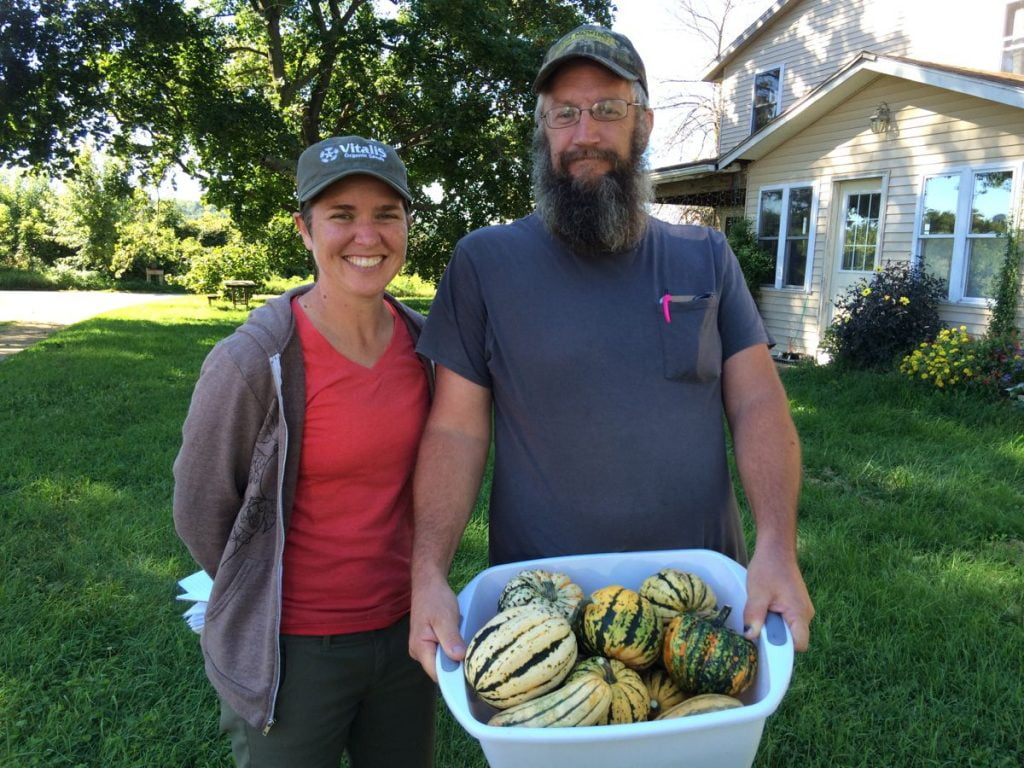
Adrienne Shelton and Paul Betz with a tub of winter squash samples I gathered to discuss with Paul.
We snagged a morning farm visit with two interesting people from seed companies. Adrienne Shelton is a plant breeder for Vitalis Seeds and Paul Betz works for High Mowing Seeds of Vermont. We buy from both companies, as well as from other companies specializing in organic seeds. Adrienne and Paul were in Wisconsin to attend the Organic Vegetable Research Showcase hosted by UW-Madison. Adrienne came to our farm to visit the trials we planted with her basil breeding lines. She is selecting for resistance to basil downy mildew, our most difficult basil disease. We’re glad to evaluate her lines under our conditions. She has some lines with good resistance. The more difficult issue is developing basil varieties that are both disease resistance and taste good.
Paul has run his own farm in Vermont for many years and is a fountain of knowledge about winter squash, my favorite crop. I was glad to swap notes with Paul about varieties and growing practices. (I think Steve is a little sick of talking with me about winter squash.) Paul and I found that we like many of the same varieties, despite our different growing environments. He had a few interesting suggestions that we will try next year. I was glad to walk our fields with Paul to get his insight about harvesting a few of the varieties we buy from High Mowing.
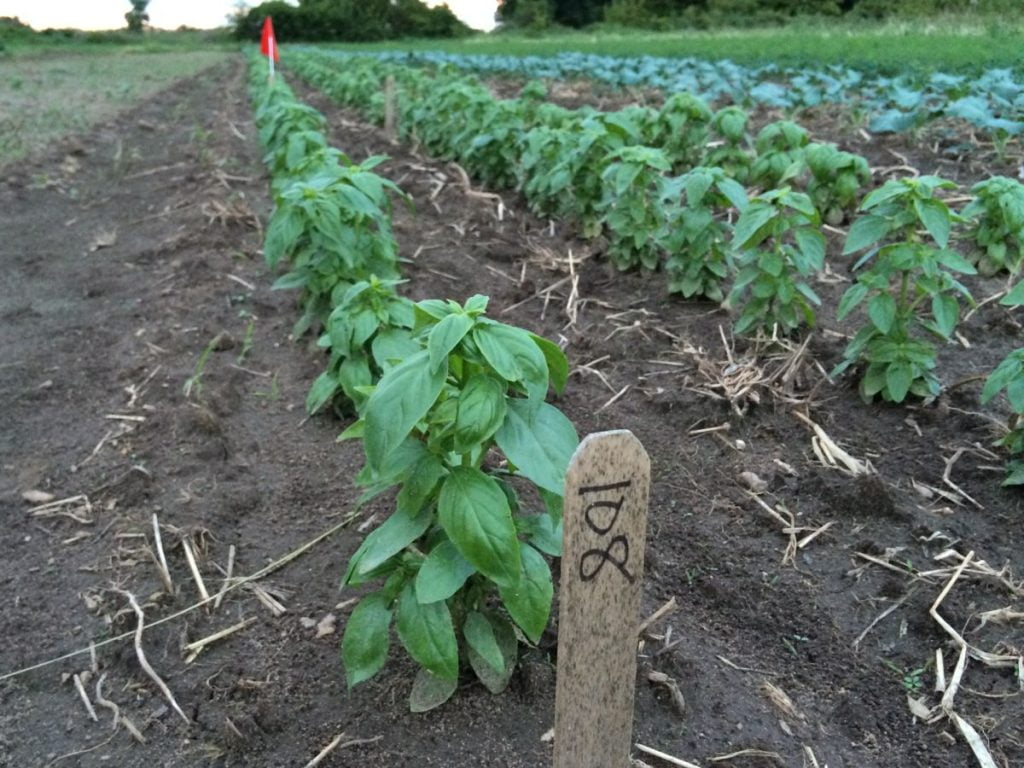
We planted Adrienne’s lines in the midst of our third and fourth basil plantings. Her company developed the disease-tolerant variety that we rely on in summer, called ‘Eleonora’. Some of her lines show improvement over Eleonora but there’s still work to be done with regard to flavor.
Farm News
Summer crops are giving way to fall crops. This delivery contains the last melons and cucumbers. This is the last burst of tomatoes. By next week, we’ll pack just a few in each box. Other summer crops will continue (beans, peppers) but now we are looking ahead to our fall crops. Steve began sampling from the sweet potato fields. If the weather forecast holds, we’ll get the first roots out within a week so they can start curing.
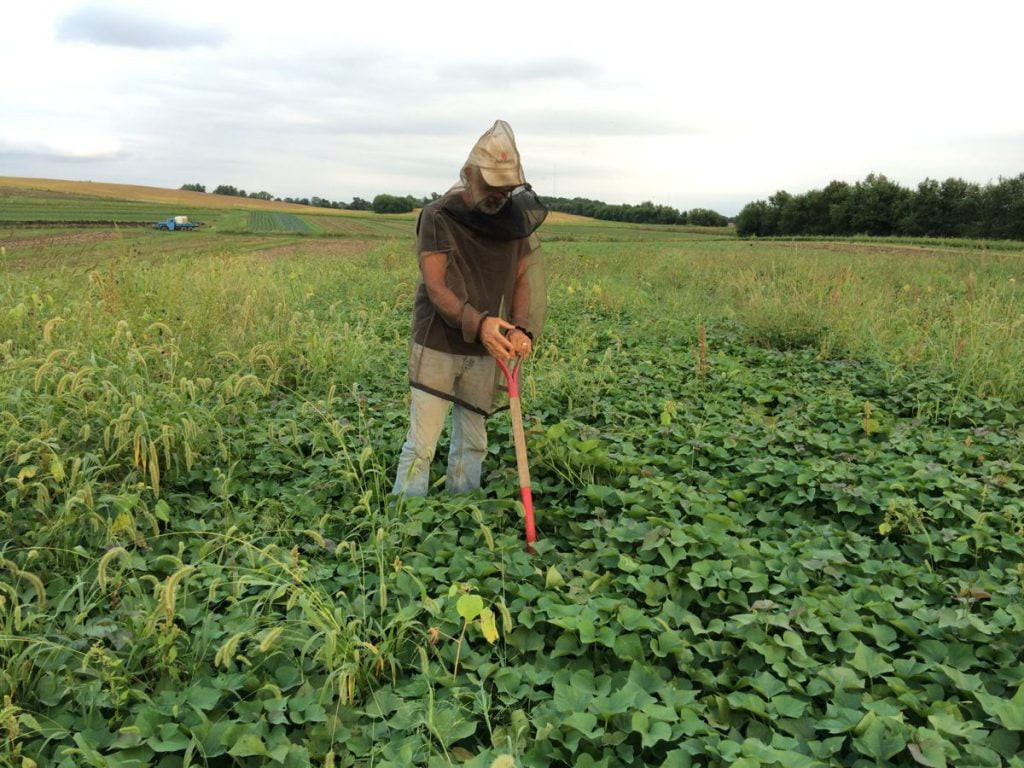
Steve digs a few sweet potato plants from our mysterious field. The vines look terrific but that doesn’t tell us much about what is happening underground.
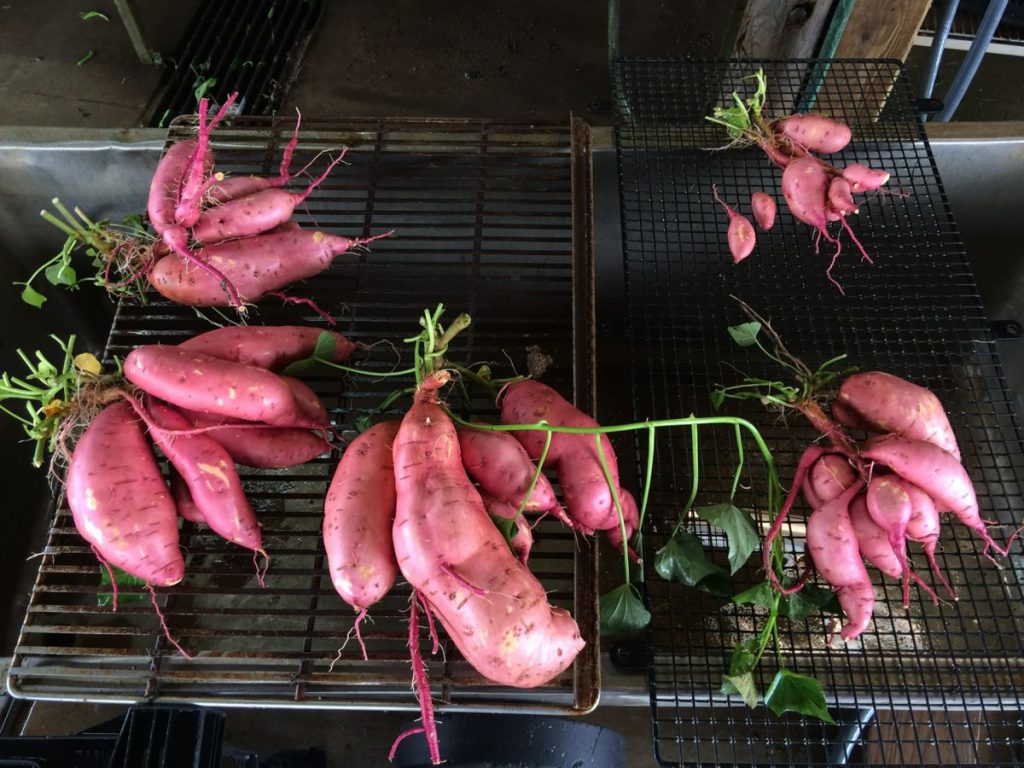
Here are the tubers from five plants. The three in the middle and on the left look unusually good for this time of year. The two on the right? Well, they could use a little more growing time.
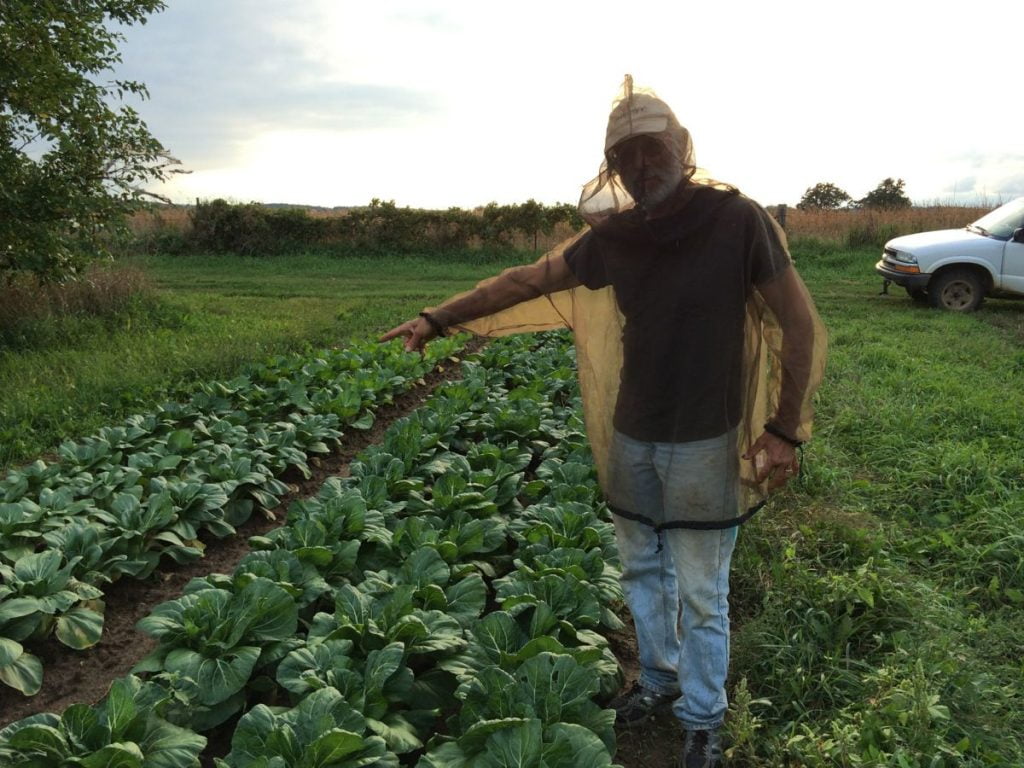
Steve chooses the bok choy for this week. We are still loving our mosquito shirts. We wear them all the time, and don’t have to use bug spray. The shirts are hot on sunny days but the relief from mosquitos is worth it.
#2 Grade Red Bell Peppers
I write about pepper grading every year. Returning members can say “yeah, yeah” and skip ahead. New members, please read. So far this year, you have received a mix and #1 and #2 grade peppers from us.
Many of the red, orange and yellow bell peppers we send in the CSA boxes will be our #2 grade. We do this to avoid waste and to deliver good value to our CSA members. The #2 grade peppers are excellent eating quality, but are not quite pretty enough to sell to stores. As a result, we place a much lower value on these peppers. This allows us to provide generous amounts of colored bell peppers over the course of the season, about three times the amount we could provide if we only gave #1 grade. We feel this is a good exchange, even if it means you occasionally open a pepper and find that it needs trimming. Here are the reasons that peppers are downgraded from #1 grade to #2 grade:
1. They may have a minor blemish, or
2. They may have minor insect damage, or
3. They may be very ripe and beginning to wrinkle. (These are especially sweet and delicious as they are fully ripe. These cannot be sold to stores because their shelf life is short. The texture is less crisp than a #1 grade pepper, but the flavor more than makes up for it.)
4. They might be partially red (or orange or yellow) and partially green.
5. Others are just too small.
The eating quality is fine (or excellent) for all these #2 peppers. We throw away all peppers that we suspect have rot inside (although one may occasionally slip through in either #1 or #2 grade.) Today’s peppers are a mix of #1 and #2 grades.
Veggie list and veggie notes (Sept. 15/16, 2016, week #18, purple EOW)
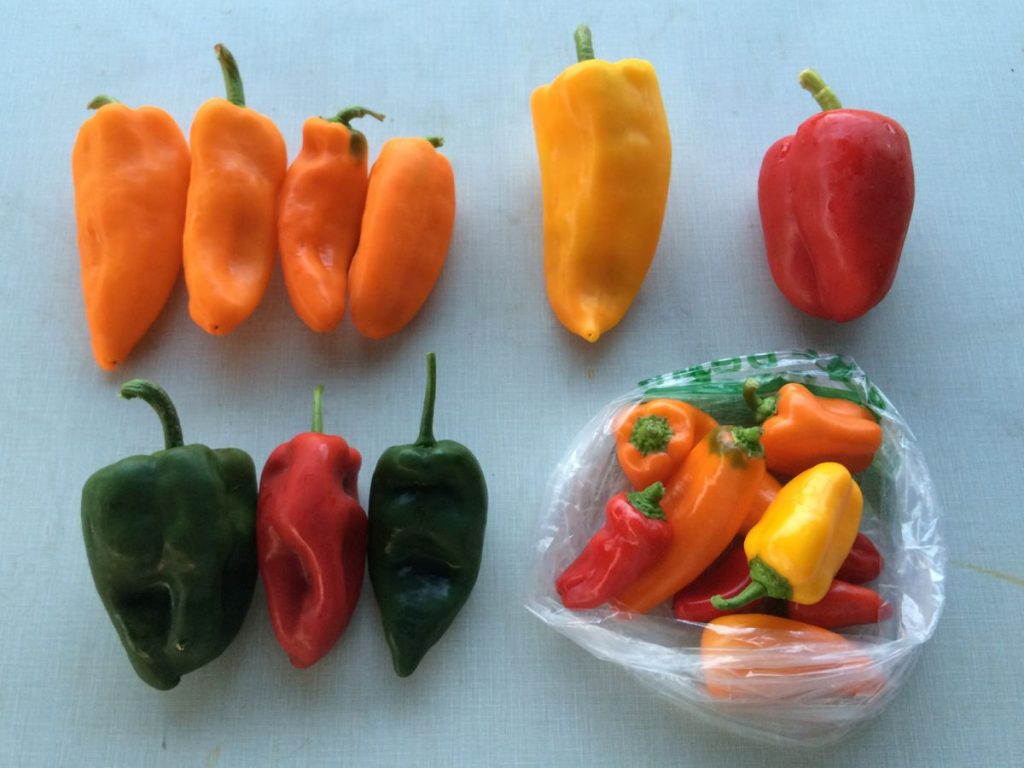
You will receive SOME of these peppers in your box. The poblano chiles are medium heat. All others are sweet peppers. Clockwise from top left; Oranos (sweet, orange), frying pepper (sweet, long, pointed, yellow or red), colored bell pepper (blocky, red or orange or yellow), Lunchbox peppers (sweet, multicolored, packed in a bag), poblano chiles (hot, triangular shape with pointed tip, can be green or red)
Bok choy
Plum tomatoes, 3 lb
(with 1 slicing tomato included)
Romano beans, 3/4 lb
Poblano peppers, 3
Yellow frying or colored bell pepper, 1
Oranos or Lunchbox peppers
Daikon radish, 1.25+ lb
Yellow onion(s)
Fresh fennel seeds & flowers
Garlic
By site, members get Sugar Cube muskmelon (plus broccoli) OR red watermelon
By site, members get Japanese eggplant OR a cucumber OR an extra bell pepper
Bok choy (large rosette with thick white stems and green leaves) – This Asian green is good for stir-frying or sautéing or in soup. You can think of the stems and leaves as two separate vegetables. The stems require longer cooking. The leaves will cook almost as quickly as spinach. Bok choy stores well, so feel free to pull off leaves as you need them, or use the whole head at once. Refrigerate in a plastic bag.
Plum tomatoes – We are nearing the end of our tomato harvests. This week’s tomatoes are still flavorful but will not store as long as usual. Plan to use them quickly.
Poblano chiles (triangular, shiny, green or red) – These are mildly hot. Poblanos are the creme de la creme of chiles. They have lots of great flavor in combination with manageable heat. Roast and add to soup or casseroles. For our household, they are emblematic of fall cooking.
Daikon radish (slender white roots) – These Asian radishes are good cooked or raw. We often make a sliced radish salad, with Asian-style dressing (rice vinegar, mirin, sesame oil, soy sauce, minced garlic). Even a brief marination mellows the radish’s sharpness.
Fresh fennel seeds & flowers (round clusters) – This anise-flavored herb can be used to season tomato sauce and other dishes. Both the yellow flowers and the tender green seeds are quite flavorful. Strip the seeds from their cluster, then crush with the flat of a knife to release their flavor. I think you could add intact seed clusters to your cooking sauce, then remove the cluster when you wish. You will still want to crush the seeds with the flat of a knife. The seeds can be added early in cooking, the flowers are better added at the end. If you shake a flower over your hand, it will release a yellow dust. This is fennel pollen, and it gives the flowers their intense flavor.
Garlic – This week’s garlic is from John Hendrickson of Stone Circle Farm.
Next week’s box will probably contain cabbage, peppers, carrots, onions, an herb and more.
Recipes from Lauren
TOMATO, ONION & FENNEL SALAD
Simple, fresh and delicious, this light tomato salad is the perfect way to say goodbye to tomato season. I’m tempted to make these gluten-free roasted poblano waffles and top them with some sour cream and this tomato salad, but you see my other recipe. I didn’t want to throw much at you this week 😉
Takes 15 minutes
Serves 4-6
8-10 plum tomatoes, cored, halved and thinly sliced
1 sweet onion, thinly sliced
All the fennel flowers you’ve got, flowers removed from stalks and roughly chopped
1/4 cup olive oil
2 tablespoons lemon juice
1 teaspoon Kosher salt
1/4 teaspoon freshly ground black pepper
Toss all ingredients together in a large bowl and stir to combine. Enjoy!
————
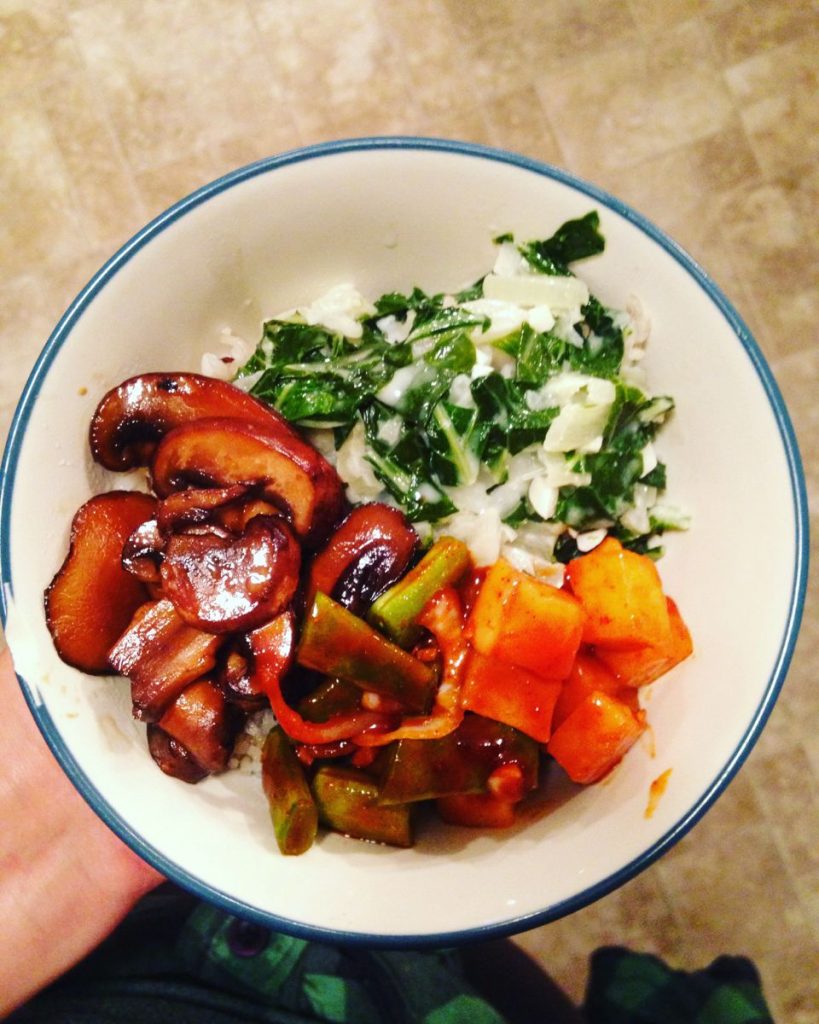
CRISPY KOREAN RICE BOWL
Now this recipe is similar to last week’s chickpea and tomato flatbreads due to the fact that it also has a lot of components (and obviously a very long list of ingredients), but I promise it really is not so difficult. Just follow along and allow enough time. Take a weekend day or evening and have a bunch of fun with your family in the kitchen making your own kimchi, crispy rice and toppings.
And if that doesn’t sound enjoyable, you could also simplify things considerably. †The kimchi can be made ahead of time and stored in your fridge for weeks. The rice doesn’t need to be crispy. It could just be ordinary rice. You technically could leave out the mushrooms (but I wouldn’t!).
As for that kimchi. All the ingredients should be regular things you can find in your kitchen with the exception of the gochujang and possibly the rice wine vinegar. You could use white wine or cider vinegar instead of the rice wine vinegar in a pinch, but the gochujung is an essential ingredient. It will be available in the ethnic food aisle of most grocery stores near the Thai or other Asian ingredients. It may also be called Korean red pepper paste.
Takes 2 hours
Serves 4-6
1-1/2 cups white rice
3 cups water, divided
1-1/2 teaspoon Kosher salt, divided
3-5 tablespoons olive oil (use peanut oil if you’ve got it, don’t worry if you don’t), divided
4 garlic cloves, minced
1 head bok choy, leaves and stems separated; leaves roughly chopped, stems thinnly sliced
13.66-ounce can coconut milk
2 tablespoons butter (use olive oil or peanut oil if vegan)
1 pound cremini mushrooms, sliced
1/2 cup soy sauce
2 tablespoons brown sugar
Daikon & Romano Bean Quick Kimchi (below), for serving
- Put rice in a fine-mesh strainer and rinse until water runs clear.
- Add rice to large sauce pan along with 2-1/2 cups water and 1/2 teaspoon Kosher salt. Bring to a boil over high heat. Once boiling, reduce to low and cover. Cook for 12 minutes then remove from heat but keep the lid on for 15 minutes.
- Heat 1 tablespoon olive oil in a large saute pan over medium low heat. Add garlic and 1/2 teaspoon Kosher salt and cook for 5 minutes. Add thinly sliced bok choy stems and additional 1/2 teaspoon Kosher salt. Bring heat up to medium. Cook 5 minutes and then add coconut milk. Bring coconut milk to a boil over high heat and then add bok choy leaves. Reduce to a simmer and cook 10 minutes until bok choy leaves are wilted.
- In a separate large saute pan, melt butter over medium heat. Add mushrooms and cook for 5 minutes just until starting to soften. Add soy sauce, 1/2 cup water and brown sugar. Let simmer gently for 15 minutes until sauce has reduced to a thick syrup.
- Keep bok choy and mushrooms on low while you crisp up the rice. Get a cast-iron skillet really hot over medium high heat. Add 1 tablespoon oil followed by rice. Press it all down and let it sit in the pan for 5 minutes until it begins to brown. Stir up the rice every 5 minutes or so, adding more oil as needed and pressing it flat after you stir it. It should take about 20 minutes total to get crispy rice. I used about 4 tablespoons of oil to get there.
- Scoop crispy rice into the bottom of a large bowl. Use a ladle to add bok choy (with sauce), followed by mushrooms with any remaining sauce and a few spoonfuls of kimchi.
.
Daikon & Romano Bean Quick Kimchi:
1 large daikon, peeled and cut into cubes
3/4 pound romano beans, ends trimmed and cut into bite-size pieces
2 tablespoons Kosher salt
2 tablespoons sugar
1/4 cup rice wine vinegar
3 tablespoons gochujang (also known as Korean red pepper paste)
1 tablespoons minced garlic
1/2 teaspoon ground ginger
1/2 teaspoon cayenne pepper, divided
1/4 teaspoon red pepper flakes
1/2 onion, very thinly sliced
- Add daikon and romano beans to a large bowl. Add salt and sugar and stir to coat evenly. Let sit for an hour at room temperature.(This is a perfect time to start the other components of your meal if making it all at once).
- Meanwhile, prepare the sauce. Combine rice wine vinegar, gochujang, garlic, ginger, 1/4 teaspoon cayenne pepper, and red pepper flakes. Whisk until smooth.
- After an hour has passed, rinse daikon and romano beans with cold water. Let drain for 5 minutes then return to bowl and toss with raw onion and additional 1/4 teaspoon cayenne pepper. (This will help you get that beautiful red color associated with kimchi).
- Add sauce and stir to combine. Use immediately or place into a sealed container (mason jars work great) and leave on the counter for 24 hours. After 24 hours, pace in your†fridge and store up to a month.
.
This makes A LOT of kimchi. About five cups. You will likely only use 1/6 of it during this meal but keep it around, it’s good on EVERYTHING!
————
Local Thyme Recipes
Comforting Classics
Roasted Garlic Hummus with Peppers
Insalata de Riso
Bibimbap with Radish, Bok Choy, Peppers and Ground Pork (vegetarian notes in recipe)
Pasta Puttanesca
Outside the Box Recipes
Bagna Cauda
Coconut Braised Romano Beans
Wakame and Daikon Tsukemono
Couscous with Tomato and Onion
Quick and Easy Meal
Gallinippers
- On: September 07, 2016
 0
0
We live in a cloud of mosquitos, worse than we have ever experienced. The marsh adjacent to our farm is a likely breeding ground, plus all the patches of standing water. I bought mosquito shirts for our entire crew. Averaging $13 per shirt, they are worth the money. It is more difficult (and hotter) working in the shirts but they have saved us.
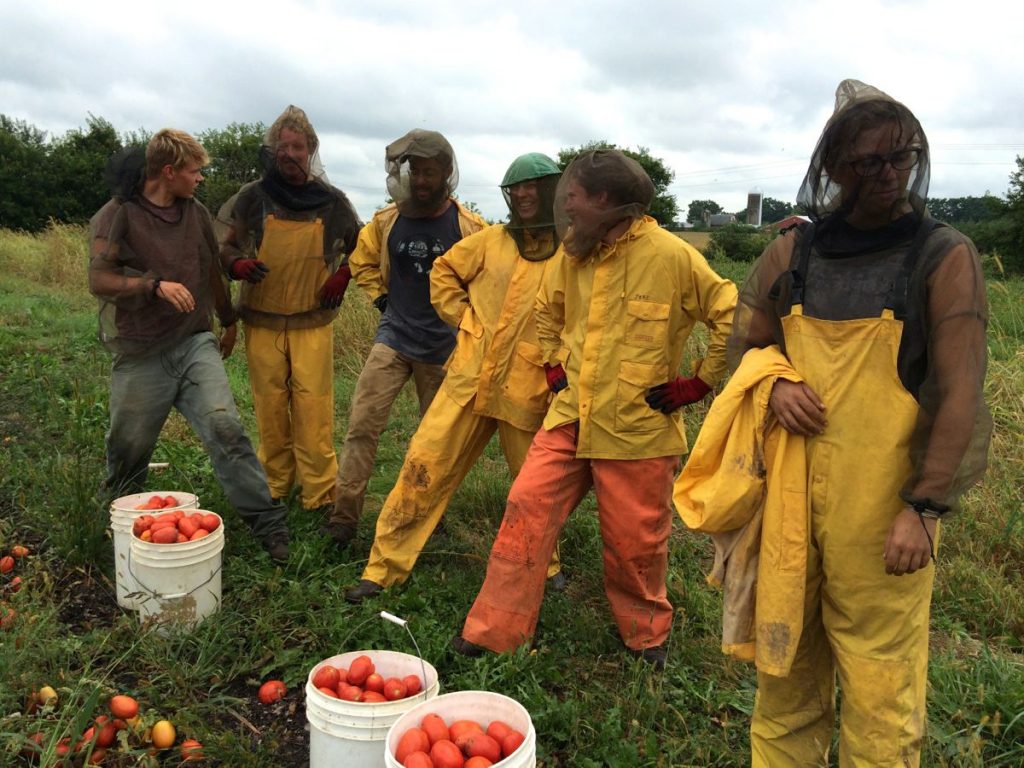
The mosquitos still swarm around us but can only bite where the netting touches bare skin. From left, Michio, James, Sean, Charlotte, Jory and Kelsie show off their farm outfits.
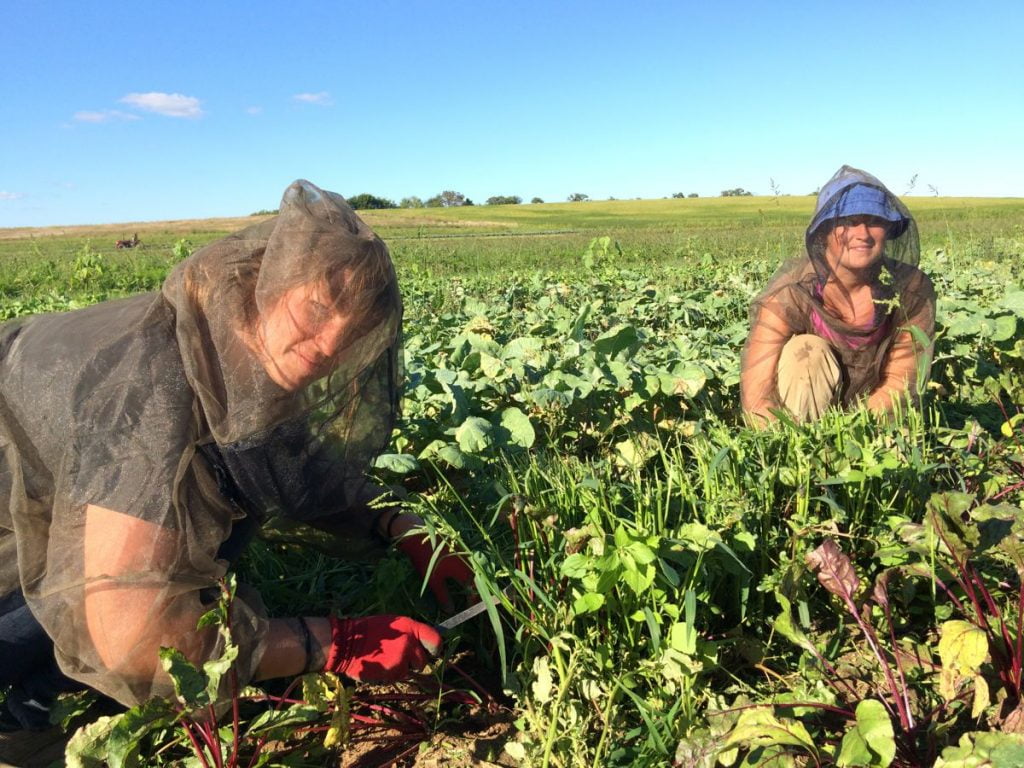
This is a telling photo. It was a sunny, breezy day but the mosquitos still swarmed us. From left, Charlotte and Jackie weed beets.
For the first time, we are seeing gallinipper mosquitos, known for their enormous size and painful bite. They draw a lot of blood, leaving substantial splats when you catch one. Dr. Susan Paskewitz of UW-Madison identified a live sample for me. She says they are not that common in Wisconsin but they show up in unusually wet years, particularly south of Madison. Fortunately, they do not transmit any human pathogens.
About those beans …
Veggie list and veggie notes (Sept. 8/9, 2016; week #17, green EOW)
Red potatoes, 3 – 3.5 lb
Slicing &/or plum tomatoes, ~4 lb
Broccoli, ~1.5 lb
Romano beans, 1.6 lb
Frying &/or bell peppers, ~3
Orano or lunchbox peppers
Yellow onions, 1 – 2
Garlic, 1 bulb
Spearmint, 1+ sprigs
Some sites will get yellow watermelon.
Some sites will get a small muskmelon plus a cucumber
Red potatoes – These potatoes were grown for us by John Hall at his farm near East Troy.
Slicing tomatoes – The yellow slicing tomatoes are the ripest and should be eaten first.
Yellow onions – These are more pungent and better for frying than the Walla Walla onions we sent over the last weeks.
Spearmint – This is from our brand-new mint garden, planted this spring. It is a variety called “Kentucky Colonel Mint”. The plants are establishing nicely. We will pack just a large sprig or two. I don’t want to harvest heavily while the plants are young. Some sprigs have flowers or buds because we delayed harvests so the plants could get well established. Our old mint garden gradually faded away as the surrounding trees grew and shaded the area. It’s nice to have a new plot established.
Melons – Everone gets either a Yellow Doll watermelon or a small muskmelon called “Sugar Cube.” This is a new variety for us but very tasty.
RECIPES FROM LAUREN
FALAFEL-SPICED TOMATOES & CHICKPEAS ON FLATBREAD
Inspired by one of my favorite Bon Appetit recipes
Now this is what we call a weekend recipe. It doesn’t take too long (unless you make the flatbreads from scratch, then things start to drag out a bit), but it does create many dirty dishes. It isn’t necessarily a quick recipe, but it is simple and the end result is a food adventure I think you will enjoy taking. I find the spices and herbs of this dish endlessly interesting. I’ve adapted the original recipe to simplify it a bit, but maintained all the yummy flavors! Flatbread can certainly be store-bought instead of homemade to save one step.
Also, if you can’t find sumac, za’atar is a yummy spice blend of sumac and thyme. That will absolutely work. If you can’t find either, paprika will make a fine substitution.
Takes 1 hour (plus 40 minutes if making flatbread from scratch)
Serves 4
2 garlic cloves, minced
1 teaspoon sumac (see note above)
1/2 teaspoon crushed red pepper flakes
1/2 teaspoon ground coriander
1/2 teaspoon ground cumin
1 teaspoon Kosher salt, plus more
1 pound tomatoes, preferably mixed colors, thinly sliced
15.5-ounce can chickpeas, rinsed
2 tablespoons red wine vinegar
Freshly ground black pepper
1/2 sweet onion, very thinly sliced
3 tablespoons olive oil
Yogurt Sauce:
1 cucumber, if you’ve got it, peeled and diced
1/2 cup plain Greek yogurt (preferably full fat)
Mint, coarsely chopped, all you’ve got (up to 1/2 cup)
Kosher salt and freshly ground black pepper, to taste
Assembly:
Olive oil
4 flatbreads (Or make your own! Recipe below)
Hot sauce
- Combine garlic, sumac, red pepper flakes, coriander, cumin and 1 teaspoon salt in a small bowl. Arrange tomato slices in a single layer on a baking sheet (or two) and sprinkle evenly with sumac seasoning. Let sit at room temperature for about half an hour.
- Combine chickpeas and vinegar in a medium bowl. Season with a generous amount of salt and pepper. Mash with a fork until†its consistent in texture. Add onion and oil and stir to combine. Taste and adjust salt and pepper as needed.
- Prepare yogurt sauce by combining yogurt and mint (and the cucumber if you have one lying around). Season to taste with salt and pepper. Cover and place in the fridge until ready to use.
- Drizzle olive oil in a large skillet over medium heat. Add flatbreads and cook for about 30 seconds on each side until warmed.
- Top flatbreads with mashed chickpeas followed by sliced tomatoes and then drizzle with yogurt sauce and a drizzle of olive oil (and hot sauce if desired).
.
Flatbreads:
3/4 teaspoon baking powder
1/2 teaspoon sugar
2 cups all-purpose flour, plus more for counter
2 teaspoons Kosher salt
1 cup plain Greek yogurt
4 tablespoons olive oil
Freshly ground black pepper
- Combine baking powder, sugar, flour and salt in a large bowl. Add yogurt and stir to combine. Transfer dough to a lightly floured surface and knead until smooth. Divide into 4 pieces and cover with plastic wrap. Let rest 15 minutes.
- Roll each piece out into a 8-inch circle. Heat oil in a large pan over medium heat. Working one at a time, cook flatbreads until underside is golden brown and it has begun to puff (about 2 minutes). Flip and cook on the other side for 1 minute. If using immediately, no need to reheat on a skillet (as in step 4).
————
WHITE CHEDDAR BROCCOLI SOUP
Cheddar broccoli soup is a fall favorite. I know we’re not quite to cool temperatures yet, but I know we are going to get there soon! Our house is already embracing soup season. I love to spruce up plain old cheddar broccoli soup with some potatoes for extra creaminess and peppers for color and interest. The cayenne really doesn’t add a touch of heat to the final product (I promise!), but will make the flavors pop! This soup is nice and light with just enough richness from the cheese. Feel free to sub in cream or half and half for some of the milk if you like a thicker, creamier soup.
Takes 45 minutes
Serve 6-8
.
- Melt butter over low heat. Add onion along with 1/2 teaspoon salt and 1/4 teaspoon pepper and turn up to medium. Cook 5 minutes until fragrant. Add peppers and cook 5 minutes longer. Reduce to low, add garlic and sautÈ 5 minutes more.
- Add potatoes, broccoli, remaining salt, remaining pepper and cayenne. Bring heat back up to medium and saute for a couple minutes until well combined and lightly coated with butter.
- Add flour and stir until it coats vegetable mixture. Cook, stirring occasionally for 3-5 minutes until butter begins to turn golden brown. Once it has begun to brown, add 2 cups whole milk and quickly stir. Wait for it to simmer for a moment and then add chicken or vegetable stock. Stir to combine.
- Bring to a boil, reduce to a simmer and cook for 15 minutes.
- Add cheese and stir until melted. Puree with an immersion blender or food processor until soup reaches desired consistency. I don’t like mine to be totally chunky or totally smooth, but somewhere in between.
————
LOCAL THYME RECIPES

Comforting Classics
Marcella Hazan’s Tomato Sauce with Butter and Onion
Romano Bean and Tomato Salad
Herb Roasted Potatoes
Terrific Broccoli Sesame Salad
Outside the Box Recipes
Spanish Roasted Tomatoes and Peppers with Jamon
Lemony Braised Romano Beans
Lemon Dijon Potato and Broccoli Salad
Blue Cheese Broccoli Pie
Quick and Easy Meal
Wholegrain Mustard Roasted Potatoes with Salmon and Tomatoes

Blue cheese broccoli pie

